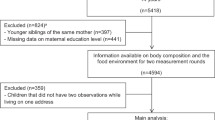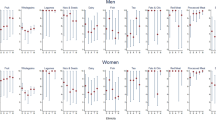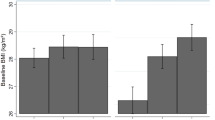Abstract
OBJECTIVE:
Many studies have shown that the prevalence of obesity is greater in lower social classes. The reasons for this effect however are unclear. Since there is also a link between education and social class, and an association between education and prevalence of obesity, one hypothesis is that lack of education about energy contents of foods may contribute to the effects of social class on obesity.
SUBJECTS:
We tested the hypothesis that knowledge of food energy contents is associated with differences in body mass index (BMI) in a sample of 346 people of both genders, aged between 18 and 45 y, of variable body mass index and drawn from different social strata.
RESULTS:
Estimates of food energy contents were on average well correlated with the actual energy contents, but individual estimates were very poor in all subpopulations of this sample. We found that subjects of different BMIs did not differentially estimate the energy contents of foods high in carbohydrate, but low in fat and protein (fruit and bread). However, foods that contained high fat contents, independent of the other macronutrients present, were generally perceived to have significantly lower energy contents by obese people than nonobese subjects (although this was not observed for all high-fat foods). Overall, this difference interacted with social class, such that the difference between the BMI groups was exaggerated in the lower social stratum but abolished in the higher social class. Binary logistic regressions revealed that the probability of being obese (BMI>30 kg/m2) in the lower social class group was significantly negatively associated with the estimated food energy content of most high-fat foods. Such an association was not found in the higher social class group. In the lower social class group, overall food knowledge appeared superior in the leaner subject group (BMI<30 kg/m2), but obese subjects were actually better at estimating the energy contents of snacks and alcoholic beverages. The leaner group significantly overestimated the energy contents of these items.
CONCLUSION:
Differences between individuals in estimates of food energy contents may contribute to the development of obesity in lower social strata. Whether this is driven by a protective effect in lean subjects of overestimating the energy contents of certain foods (snacks and alcoholic beverages) or a susceptibility in the obese because they underestimate the energy contents of other foods is not certain. Knowing which of these alternatives is true is important and may help design public health education programmes directed at these people to help alleviate the obesity epidemic.
This is a preview of subscription content, access via your institution
Access options
Subscribe to this journal
Receive 12 print issues and online access
$259.00 per year
only $21.58 per issue
Buy this article
- Purchase on Springer Link
- Instant access to full article PDF
Prices may be subject to local taxes which are calculated during checkout



Similar content being viewed by others
References
Oster G, Edelsberg J, O’Sullivan AK, Thompson D . The clinical and economic burden of obesity in a managed care setting. Am J Manag Care 2000; 6: 681–689.
Thompson D, Edelsberg J, Colditz GA, Bird AP, Oster G . Lifetime health and economic consequences of obesity. Arch Intern Med 1999; 159: 2177–2183.
Kortt MA, Langley PC, Cox ER . A review of cost-of-illness studies on obesity. Clin Therapeut 1998; 8: 772–779.
Wolf AM, Colditz GA . Current estimates of the economic cost of obesity in the United States. Obes Res 1998; 6: 97–108.
Report of the National Audit Office. Tackling Obesity in England HC 220 Session 2000–2001. 2001.
Grundy SM . Multi-factorial causation of obesity: implications for prevention. Am J Clin Nut 1998; 67: 563S–572S.
Stunkard AJ . Socioeconomic status and obesity In Origins and consequences of obesity. Ciba foundation symposia 1996; 201: 174–187.
Moore ME, Stunkard A, Srole L . Obesity, social class, and mental illness. Obes Res 1997; 5: 503–508.
Bielicki T, Szklarska A, Welon Z, Rogucka E . Variation in body mass index among Polish adults: effects of sex, age, birth cohort, and social class. Am J Phys Anthropol 2001; 116: 166–170.
Laitinen J, Power C, Jarvelin MR . Family social class, maternal body mass index, childhood body mass index, and age at menarche as predictors of adult obesity. Am J Clin Nutr 2001; 74: 287–294.
Lindquist CH, Reynolds KD, Goran MI . Sociocultural determinants of physical activity among children. Prev Med 1999; 29: 305–312.
Johnson-Down L, O’Loughlin J, Koski KG, Gray-Donald K . High prevalence of obesity in low income and multiethnic schoolchildren: a diet and physical activity assessment. J Nutr 1997; 127: 2310–2315.
Buemann B, Tremblay A, Bouchard C . Social-class interacts with the association between macronutrient intake and subcutaneous fat. Int J Obes Relat Metab Disord 1995; 19: 770–775.
Power C, Parsons T . Nutritional and other influences in childhood as predictors of adult obesity. Proc Nutr Soc 2000; 59: 267–272.
Parsons TJ, Power C, Logan S, Summerbell CD . Childhood predictors of adult obesity: a systematic review. Int J Obes Relat Metab Disord 1999; 23: s1–s107.
Sorensen TIA . Socioeconomic aspects of obesity—causes or effects. Int J Obes Relat Metab Disord 1995; 19: s6–s8.
Hardy R, Wadsworth M, Kuh D . The influence of childhood weight and socioeconomic status on change in adult body mass index in a British national birth cohort. Int J Obes Relat Metab Disord 2000; 24: 724–734.
Galobardes B, Morabia A, Bernstein MS . The differential effect of education and occupation on body mass and overweight in a sample of working people of the general population. Ann Epidemiol 2000; 10: 532–537.
Gnavi R, Spagnoli TD, Galotto C, Pugliese E, Carta A, Cesari L . Socio-economic status, overweight and obesity in pre-puberal children: a study in an area of Northern Italy. Eur J Epidemiol 2000; 16: 797–803.
Bolton-Smith C, Woodward M, Tunstall-Pedoe H, Morrison C . Accuracy of the estimated prevalence of obesity from self reported height and weight in an adult Scottish population. J Epidem Commun Health 2000; 54: 143–148.
WHO. Obesity: preventing and managing the global epidemic. Report of a WHO consultation on Obesity. Geneva, 1997, 1998.
Carstairs V, Morris R . Deprivation and health in Scotland. Aberdeen University Press: Aberdeen; 1991.
Nelson M, Atkinson M, Meyer J . A photographic atlas of food portion sizes. MAFF publications: London; 1997.
Rolls BJ, Bell EA, Waugh BA . Increasing the volume of a food by incorporating air affects satiety in men. Am J Clin Nutr 2000; 72: 351–358.
Rolls BJ, Bell EA, Thorwart ML . Water incorporated into a food but not served with a food decreases energy intake in lean women. Am J Clin Nutr 1999; 70: 448–455.
Rolls BJ, Castellanos VH, Halford JC, Kilara A, Panyam D, Pelkman CL, Smith GP, Thorwart ML . Volume of food consumed affects satiety in men. Am J Clin Nutr 1998; 67: 1170–1177.
Brinberg D, Axelson ML, Price S . Changing food knowledge, food choice and dietary fiber consumption by using tailored messages. Appetite 2000; 35: 35–43.
Wardle J, Parmenter K, Waller J . Nutrition knowledge and food intake. Appetite 2000; 24: 269–275.
Acknowledgements
We are grateful to Heather Peace for help during the design of the study and James Stubbs and two anonymous referees for comments on earlier drafts of the manuscript.
Author information
Authors and Affiliations
Corresponding author
Rights and permissions
About this article
Cite this article
Speakman, J., Walker, H., Walker, L. et al. Associations between BMI, social strata and the estimated energy content of foods. Int J Obes 29, 1281–1288 (2005). https://doi.org/10.1038/sj.ijo.0803018
Received:
Revised:
Accepted:
Published:
Issue Date:
DOI: https://doi.org/10.1038/sj.ijo.0803018
Keywords
This article is cited by
-
Perceived ‘healthiness’ of foods can influence consumers’ estimations of energy density and appropriate portion size
International Journal of Obesity (2014)



